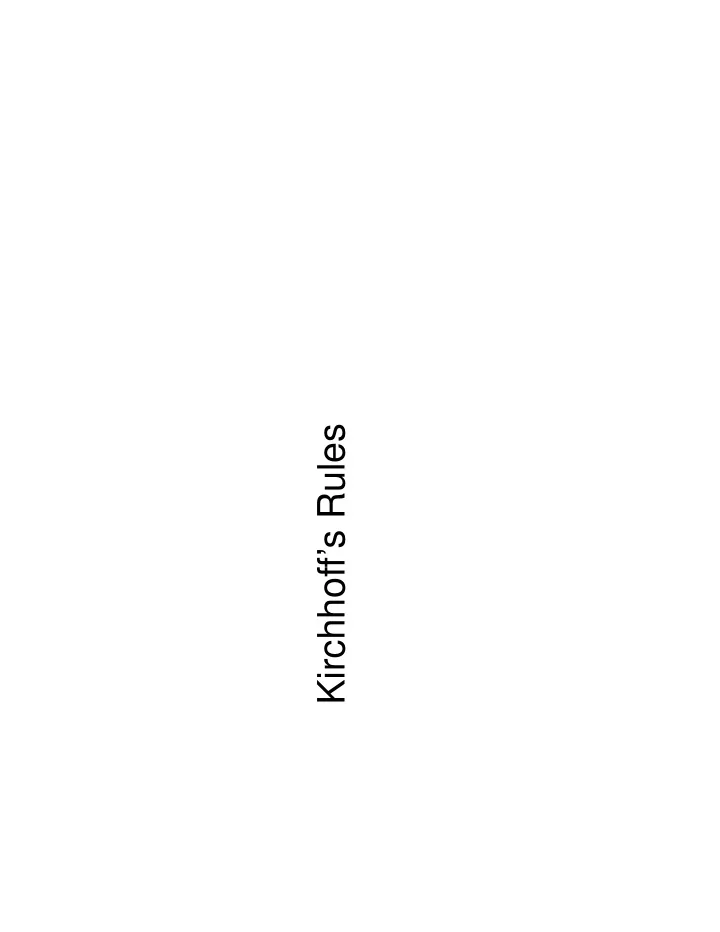

Kirchhoff’s Rules
Kirchhoff’s Voltage Rule – sign convention Use only currents as unknown variables. V can always be written in 1. terms of currents or derivatives or integrals of currents. 2. Assign current direction to every path in a circuit. Apply Kirchhoff’s current rule as much as you can to reduced the number of unknown variables. 3. Across every component in the circuit determine which end has a higher potential (mark it with a + sign) and which end has a lower potential (mark it with a - sign). This will depend on the current direction you assume in step 2. 4. Pick up a loop and travel around it either clockwise or anticlockwise. If you travel from – to + across a component, then V across the component is positive. If you travel from + to – across a component, then V across the component is negative. You can reverse this convention as long as you do it consistently for the whole loop. 5. If you get a negative current, that means the current direction you assume in step 2 is wrong and you should reverse that direction.
Kirchhoff’s Voltage Rule – sign convention Example: C + - I Q + + IR 0 R C - V V - R bat V C As you travel around a loop, if you find yourself moving from + to - , make V across that component negative (C and R in this example).
Class 25: RC Circuits
RC Circuits – Charging At t=0, capacitance is uncharged and C Q=0 (initial condition). At t=0, switched is closed, it the capacitor has no charge, it behaves like a conductor and I= /R. R After the capacitor is completely charged, Q=C , V C = and V R =0. I=0 and the capacitors behave like an insulator.
RC Circuits – Charging q q d q IR R C C d t C CR dq (C - q) dt dq 1 Integration constant - dt q - C CR t n( q - C ) - K' CR R t - K' CR q - C Ke (K e ) t - q C K e CR At t 0, q 0 0 C K K - C t - q C ( 1 e CR ) t t dq C - - I e CR e CR d t CR R t - V IR e CR R V R + V C = t q - CR V (1 - e ) C C
RC time constant =RC is known as the RC time constant. It indicates the response time (how fast you can charge up the capacitor) of the RC circuit. t - CR I e R I e 2.72 R - 1 e 0 . 37 - 1 I e R ~ 0 . 37 R t t=RC t - CR q C ( 1 e ) q C 2 1.414 -1 q ( 1 e ) C 1 ~ 0 . 63 C 0 . 707 2 t Nothing to do with RC circuits t=RC
RC Circuits – Discharging At t=0, capacitance is charged with a charge Q (initial condition). At t=0, switched is closed, the capacitor starts to discharge. C R After the capacitor is completely discharged, Q=0, V C = 0, V R =0 and I=0.
RC Circuits – Discharging q q d q d q 0 IR R 0 (I - ) C C d t d t CR dq - q dt dq 1 Integration constant - dt q CR t C n q - K' R CR t - K' q Ke CR (K e ) t - q K e CR At t 0, q Q Q K t - CR q Qe t dq Q - CR I e d t RC t Q - CR V IR e R C V R + V C = 0 t q Q - V e CR C C C
In Summary For both charge and discharge, Q, I, V C , and V R must be one of the following two cases: y y 0 t - y RC y 0 e t y y t - RC y y (1 - e ) y can be Q, I, V C , or V R t
Recommend
More recommend